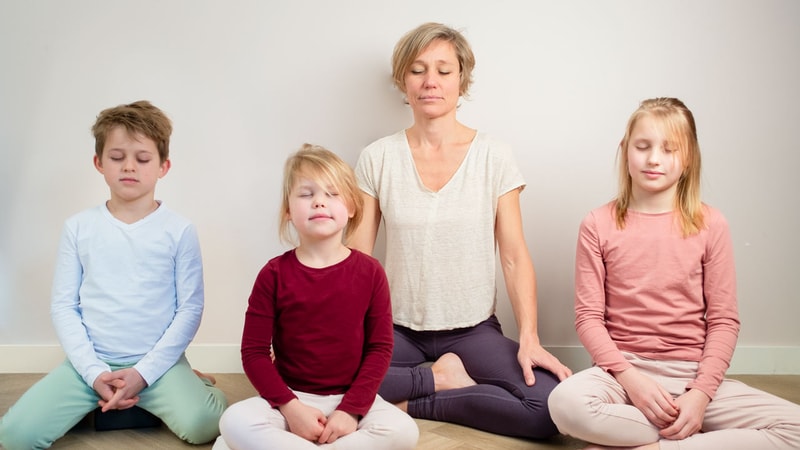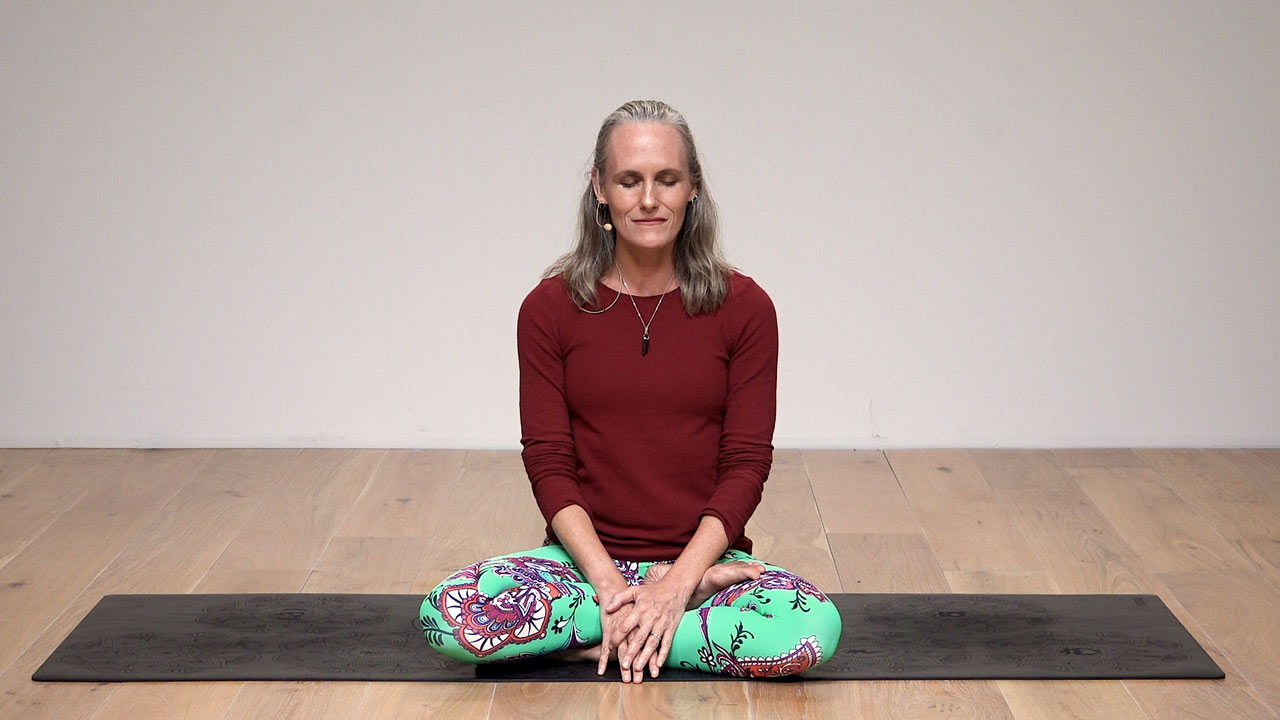How often have your kids come to you at 10 or 11pm, looking dishevelled or upset, saying “I can’t get to sleep!”? When my kids were growing up and had difficulties sleeping, there were a few yoga-based techniques I used to help them calm down, relax and unwind from the day. Below, I’ll outline four of the most effective ways I found to help my kids get to sleep.
When I asked my now 18-year-old son what worked best when he was young and struggling to drift off, he said: “The things that helped me focus on one thing instead of getting caught up in the flurry of thoughts in my mind.”
I thought this was a very wise statement as it gets to the heart of what yoga is all about in the first place: generating a one-pointed focus in order to quiet the peripheral activity in the mind and rest in a deeper awareness.
Of course, we always teach and share best what comes from our own experience, so I encourage you to try these techniques for yourself. Find out what works for you and add your own unique flavour to them when sharing them with the kids in your life.
Try our Meditations for kids program
Soothing audio meditations for children aged 3 and above – to aid sleep, relieve anxiety and promote self-acceptance.
1. Ask: What they are experiencing in their body and mind?
I usually start with a question like, “What does it feel like in your body?” Sometimes night-time restlessness is caused by cramps or physical discomfort. When my kids were growing up, they would often get cramps in their calves at night. If that happened, I would have them drink some water and do some stretching to try to ease the discomfort.
Most of the time, however, restless nights were caused by an overactive and distracted mind. After making sure they weren’t experiencing pain or severe discomfort in their body, I would encourage my kids to look at what was going on their minds. I would ask them:
- How many thoughts they were having at a time?
- Did they feel like a big ball of thoughts, all tangled up together?
- Or layers of thoughts, one on top of the other?
- Or maybe a long string of thoughts, one after the other?
Creating some space
It’s helpful to step back and look at the structural patterning of thoughts – even using a visual analogy of how thoughts are emerging within the mind. Doing this helps to create a bit of space between the thoughts themselves and the power they have over us when we give them our full attention and involvement.
I would then ask:
- What do those thoughts feel like?
- What do the thoughts contain?
- Is there a certain energy in those thoughts that make you feel a certain way?
For instance, if my kids were worried about an upcoming event, it may make their “tummy feel like it’s on a rollercoaster.”
By considering these questions, it encourages kids to take an even bigger step away from their involvement in their thoughts. They can see how the thoughts they have – and how the energy of those thoughts – affect how they feel. For example, the energy of their thoughts may make them feel uneasy in their bodies – e.g. butterflies in the belly, tension, a headache, sometimes even pain.
Furthermore, kids may also begin to see that thoughts are “things” that arise in the mind; they are NOT who we are. And that thoughts only have power over us when we give them our attention.
After we’d ‘checked-in’ to see how their bodies and minds were feeling, I would try a few different ways to calm down their mind. These techniques help them to relax and encourage them to move their attention away from the contents of their thoughts, so that they could rest in a state of deeper awareness
2. Do a body scan
There are many body scan techniques to help kids get to sleep. When my kids were really young, we would simply say goodnight to each body part: “Goodnight, toes. Goodnight feet. Goodnight legs…..” Sometimes I would guide the process, going through each body part and saying “goodnight,” as if we were tucking each part in to go to sleep. Usually, my kids would add their own twist:
“What about fingernails, Mama?”
“Oh yes, goodnight fingernails…..”
“What about bones?”
“Goodnight, bones.”
We would include teeth, eyes, blood, skin – anywhere in the body that could possibly hold tension – and give it permission to rest, relax, and go to sleep. At the end, we also said “goodnight” to the entire body and the mind. By then, the focus on external thoughts had usually quietened down, and my kids were able to fall asleep.
You can add many variations to this, like ‘untying the knots’ of tension in each part of the body. Or ‘combing’ through the tangles that keep them from sleeping peacefully. Another variation is adding a mental or energetic hug or smile to each body part as you mention it.
Here’s a Body Scan class from Taetske to get some more ideas from.
3. Practice breathing techniques
There are many breathing techniques which can be used to help kids relax. These are just a few that I found to be effective:
Gentle breath in, deep breath out
Lying down, breathe in slowly and feel how the breath fills up the body.
Exhale thorough the mouth like a deep sigh, and let the out-breath relax the whole body.
Inhale, listen to the sound the breath makes.
Exhale through the mouth and let the front of the body soften down toward the back of the body, and how together they relax in stillness.
With each inhale, focus on one thing: the sound, a sensation, the temperature of the breath, etc. And with each exhale, allow a full release and settling into stillness and relaxation.
Counted breath
You could also try breathing in for a slow count of 4, and exhaling through the mouth for a slow count of 6, following each exhale deeper into stillness. If the 4:6 ration is not suitable or causes tension or strain, the ratio can be modified to anything that is comfortable. Just make sure that the exhale is slightly longer than the inhale, like 2:4 or 3:5.
Repeat this a few times and see how your child feels afterward.
Bumblebee breath (Bramhari pranayama)
This Bumblebee breathing technique is always a favourite. It is easy, and I have found it to be amazingly effective.
Lying down, breathe in comfortably. Then exhale with the mouth closed, making a soft humming sound, like the gentle hum of a bumblebee (the sound “mmmmmmm”), from the beginning of the exhale to the very end.
Practice this 3-5 times and rest in stillness and the calm space it creates within.
Bumblebee breath has a wonderfully restful effect on both the body and the mind. It stimulates the vagus nerve and sends the body into a parasympathetic state of ‘rest and digest.’
4. Try sound vibration and mantra
Using sound vibration is great way to invite relaxation into the body. It also helps bring the mind to a one-pointed focus. Here are some ways that sound vibration has helped my kids relax and go to sleep over the years:
Tibetan Singing Bowl/Chimes
A Tibetan Singing Bowl is a wonderful thing to use with children. Its sound is so resonant and I have yet to meet a child who doesn’t melt into relaxation when bathed in its sound. If you don’t own a Tibetan Singing bowl, you could use finger chimes, or a deep-sounding bell – or search the internet (or find Apps) for chimes and singing bowl sounds.
Have your child lie down and ask them to take a few deep breaths. Then ask them to close their eyes and ‘listen’ to the sound of the bowl / bell / chimes with their whole body. See if they can hear or feel the sound somewhere within them. Ask that they keep their eyes closed until the point where they can no longer hear the sound.
Repeat a few times until your child feels relaxed and ready to go to sleep.
Bija Mantras/Sounds/OM
This was both my son and daughter’s favourite thing to do at bedtime. They called this yoga-based technique “Sounds” and would ask to me do it almost every night when they were very small. I would chant the mantras, and they would listen and relax.
The Bija Mantras are short, one-syllable sounds that correspond to the different chakras, or energy centres, in the body. Here’s one I’ve recorded already, but I’ll film a class specifically for kids.
Chakra Mantra: Deep Relaxation
A deeply restful meditation journey through the chakras using the sound vibration of Bija Mantras.
It’s also just fine to use a few long, soft chants of OM to help kids relax and go to sleep. Even a soft chant of vowel sounds can be very calming: “Aaaaah”, “Eeeeeee,” and “Oooooh.”
Mantras carry an energetic vibration, which is calming and relaxing to the body and mind. Listening to the sounds also brings the mind out of distraction and into a deeper state of peace and natural rest.
I hope these yoga-based tools, which involve body, breath, and mind help you and the children in your life fall asleep with more ease so that you all have peaceful rest throughout the night.
I’d love to know what tips and tricks you have for helping your kids get to sleep – please share them in the comments section below!
With love,
Tracey
*Photo courtesy of Annie Spratt, on Unsplash



